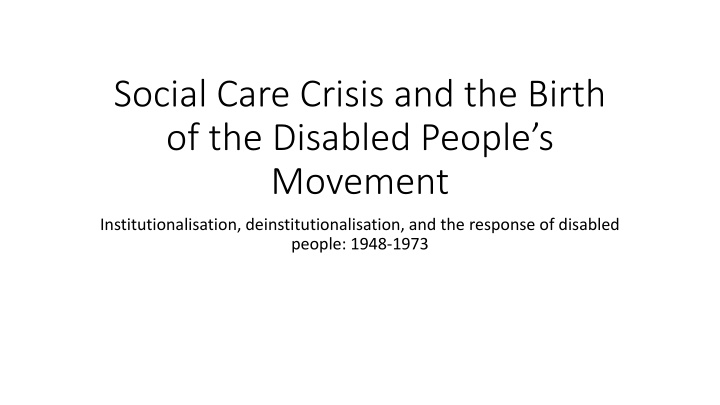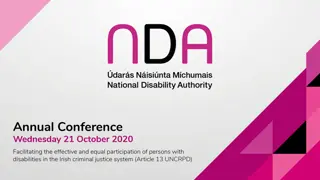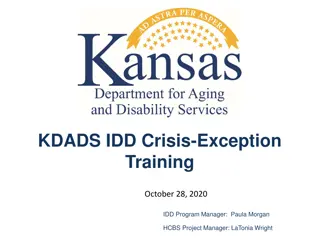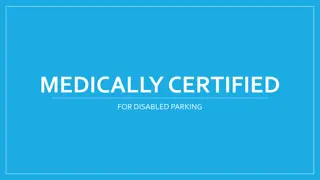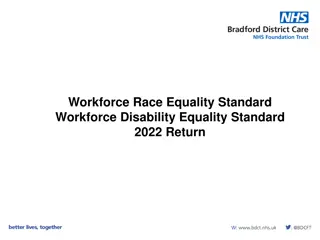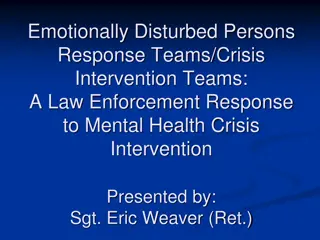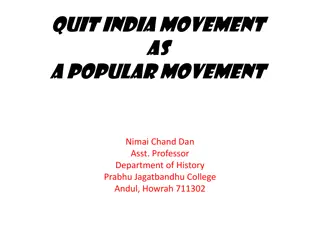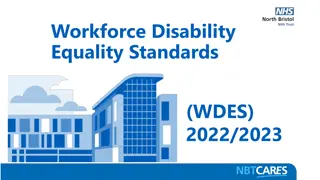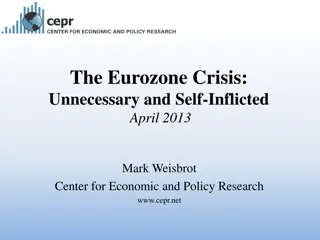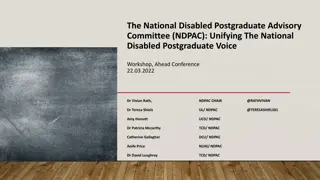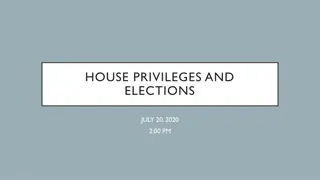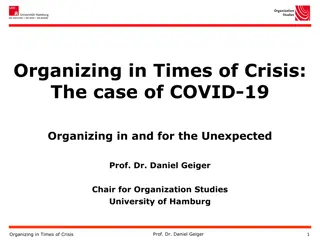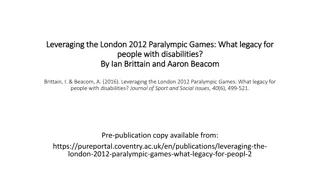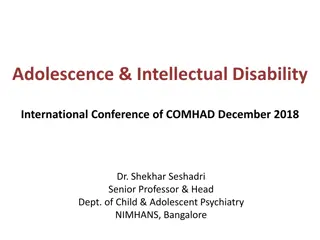The Emergence of Disabled People's Movement: Crisis and Response
This research delves into the birth of the Disabled People's Movement (DPM) amidst crises of institutionalization and deinstitutionalization from 1948 to 1973. It rethinks the causes and consequences of the early DPM, highlighting the impact of a social care crisis on disabled individuals. The narrative explores how the DPM emerged in response to unfulfilled promises of freedom, dignity, and integration for disabled people as institutions failed to deliver.
Download Presentation

Please find below an Image/Link to download the presentation.
The content on the website is provided AS IS for your information and personal use only. It may not be sold, licensed, or shared on other websites without obtaining consent from the author.If you encounter any issues during the download, it is possible that the publisher has removed the file from their server.
You are allowed to download the files provided on this website for personal or commercial use, subject to the condition that they are used lawfully. All files are the property of their respective owners.
The content on the website is provided AS IS for your information and personal use only. It may not be sold, licensed, or shared on other websites without obtaining consent from the author.
E N D
Presentation Transcript
Social Care Crisis and the Birth of the Disabled People s Movement Institutionalisation, deinstitutionalisation, and the response of disabled people: 1948-1973
The basis for this talk Research I ve done while editing the Collected Works of Paul Hunt Unpublished, out-of-print, or private papers held in the Leonard Cheshire Archives and the Disabled People s Archives in Manchester Recent scholarly work on anti-institutional struggles in the 50s and 60s (esp. Claire Hilton) and disability policy (Jameel Hampton & Gareth Millward), and activist accounts of the early DPM (esp. the work of Judy Hunt, Maggie Hines, and the editorial work of Tony Baldwinson)
Those who teach history sometimes lead us to believe that even such a complex phenomenon as a revolution, or such an intermediate thing as a movement, have their beginnings in specific events involving certain people and their activity at a particular moment of historical time. ( ) [W]e must also remain aware that these terms have been invented to describe significant combinations and interactions of ideas and activities, and of people and places all with their own different histories rather than any simple, linear unfolding of events - Dick Leaman and Yutta Fricke (1994)
Rethinking the Early DPM Causes and Consequences Institutions have dominated histories of disability as a social phenomenon, but have been curiously absent from histories of disability politics (until recently). Traditional view: DIG (interested in welfare rights) splits to form UPIAS (interested in social rights), which broadens to form BCODP (interested in civil rights) each correcting the limitations or weaknesses of the one before. In this view, institutions are simply arbitrary evils that the DPM confronts, as opposed to something they treated as a distinct part of disabled people s oppression, or a tradition that it learned from.
Rethinking the Early DPM Causes and Consequences I argue, instead, that the early DPM (especially UPIAS) can only be understood by looking at a crisis of institutions (and social care more generally) in the 60s and 70s. This was partly a crisis of too little cash (particularly capital costs), but mostly a crisis of deinstitutionalisation. Deinstitutionalisation, and the charities who d promoted it, had promised disabled people freedom from control and domination, a dignified standard of living, and integration into mainstream life. The DPM emerges as it becomes obvious these promises are failing
Evidence The letter forming UPIAS was about social care not incomes, rights, etc Current and former residents of institutions dominated the early organisation (3/4 of it s first executive committee, half of it s regional organisers, 2/5 of it s conference committee) Institutional struggles made up most of UPIAS members early campaign work. The institutional question comes up constantly in their publications
Deinstitutionalisation timeline (Legislation) National Health Service Act & National Assistance Act (1948) Abolishes the Poor Laws, takes all hospitals under public control; insists that councils arrange housing for any poor person in their area (either through social housing or charities) Mental Health Act (1959) Abolishes lunatic asylums and indefinite involuntary detention for people with mental distress Chronic Sick and Disabled Person s Act (1970) Urges Government to consult with disabled people on community services, to provide accommodation for disabled people in Burrough National Insurance Act (1970) Introduces Attendant Allowances for some disabled people to avoid admission to institutions.
Deinstitutionalisation and the Charities Taking the hospitals into public control made the government responsible for everything that happened there. Soon, there was public outcry about the treatment of older and mentally distressed people, oppressed at the tax-payer s expense. What the welfare state hadn t provided (yet) were residential homes outside the hospital system. New charities set about providing these themselves; based on an argument that they could do deinstitutionalisation better than the government. Eventually, however, they had to find accommodations with the existing state institutions joining a welfare system which minimised differences between state and charity providers
The Cheshire Foundation for the Sick Started in 1948 in Hampshire on the back of a Christian Socialist commune for ex-soldiers The first Home s rules, routines, and activities were negotiated between a residents committee, staff reps, and a Warden An extensive network of volunteers provided skills training to residents and access to wider society. A blossoming internal cultural scene residents became artists, novelists, film-makers, journalists, designers, etc
[Cheshire Homes are] run as homes rather than hospitals (...) [which] offer the affection and freedom of family life, the patients being encouraged to take whatever part they can in the day-to-day running of the home Cheshire Foundation Mission Statement (1958)
The Spastics Society Started in 1952 by parents of children with Cerebral Palsy Based on the belief that the rehabilitation techniques and technical aids invented during the war meant there was no need for their children to live in a hospital, or to be unemployed. Set up hostels, colleges, and day-centres focussed on getting young people with CP into gainful work, living outside of hospital, and controlling their own social life Devolved power over some local aspects of the Society s work (fundraising, social events) to self organised groups of residents in 1962
We look in the future to the creation of an adequate number of [self- organised] groups to serve all spastic people throughout the length and breadth of England and Wales, to raise funds when required for the purpose, and to fly the flag for the Society so that the public sees the spastic person in a true perspective. We look also (...) to the provision of suitable activities which will encourage spastics to come out of their shells and bring them to realise that not only have they a rightful place in society, but that society is anxious they should fill it Spastics Society press release (1962)
Charities as (pseudo) Social Movements Based on a vision of change social inclusion, individual freedoms for residents, community life Defined themselves in opposition to the status quo they were not the hospitals, not the old Workhouses, etc and as outside the existing system of social care. Mobilised residents (individually and collectively) to fight the charities corner. Residents had to be active in the world, to be exercising their freedoms in public, to prove that the charities were superior to the State
The crisis of deinstitutionalisation in the charities Stream 1: As the charities grew, it was necessary to take on more and more layers of management. Culturally, managers were often opposed to residents freedoms, and unruly residents interfered with running large and expensive institutions Stream 2: The state threatened to nationalise the major care charities; creating panic at their top. Charity leaders scrambled to take on medicalised roles that NHS managers didn t want to fulfil to protect their positions medicalising the Homes and reducing residents control over their lives.
Residents resistance: The Cheshire Homes Began as a local dispute about new House Rules and the expulsion of one resident who had insulted a manager A residents and workers campaign prevented the expulsion, and led to the resignation of the Matron who had ordered it. Soon Leonard Cheshire, seeking to medicalise the Homes routines, was forced to start a debate in the Foundation s journal about who did, or should, control the organisation. In the end, Cheshire got his way; but a mass uproar from residents (and some workers) slowed down his timetable dramatically
Residents Resistance: The Spastics Society Began as a dispute over staff rotaing and bed-times between students at Oakwood College and it s headmaster with the students taking the issue to the conference of self organised groups in the Society. Extended as more residents began to air their grievances publically on abusive staff, infantilising care regimes, and rigid approaches to work and education Ended up with residents demanding consultative rights on all aspects of Society policy
Fallout: Reaction in the charities The residents campaigns for greater control over the charities lost at best slowing down authoritarian reforms, rather than stopping them. The charity leaders were forced to pick a side nearly all references to residents autonomy and criticisms of the hospitals were dropped from their speeches and publications, and they began to construct arguments for why residents could never control their own services. At around the same time, the state lost interest in serious alternatives to institutions, or in nationalising them, and became increasingly reliant on them to take pressure off of the health service.
Fallout: Self-organisation outside the charities Utter loss of faith in reform through residential institutions: we may have got as far as we can here (Paul Hunt private letter 1967). Participants in residents struggles are some of the first to join DPOs in the 70s particularly UPIAS, but also the Spinal Injuries Association, Derbyshire CoDP, etc. A growing awareness that institutions aren t just themselves systems (inputs, outputs, laws of motion and authority), but that they are part of a wider system although a lot of argument about what that is or why institutions are so important to it
Conclusions for us today The social care crisis wasn t the only thing that caused the DPM to form, but there is a direct link from the failure of deinstitutionalisation to the growth of the movement A crisis in social care (or anything else) should be the time when we think most deeply about why things work as they do and what alternatives are available It can also lead to an increase in militancy, and to creative solutions to the problems that cause crisis in the first place no matter how hopeless it feels at the time
